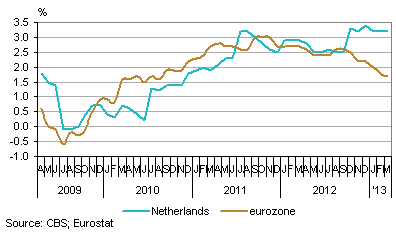Dutch inflation rate marginally lower

The Dutch inflation rate was 2.9 percent in March, i.e. marginally lower than in January and February, when the rate was 3.0 percent. Inflation is defined as the increase in the consumer price index (CPI) in a particular month compared to the same month in the previous year.
Price developments of motor fuels in particular had a downward effect on inflation in March. The VAT rate for home and garden maintenance was reduced from 21 to 6 percent in March, which also had a downward effect on inflation. Price developments of tobacco products had an upward effect, just as price developments of clothing and shoes.
Dutch inflation rate

The harmonised consumer price index (HICP) allows comparison between the inflation rates in the various member states of the European Union (EU). The level of inflation in the eurozone is one of the main guidelines for the European Central Bank (ECB) to change or refrain from changing the interest rate. According to the ECB, prices in the eurozone are stable, if the inflation rate is close to 2 percent.
According to the HICP method, the inflation rate in the Netherlands was 3.2 percent in March, the same as in January and February. Eurostat, the European statistical office, calculated an inflation rate of 1.7 percent for the eurozone. The eurozone inflation rate has fallen over the past few months. For more information, the reader is referred to the article Dutch inflation considerably above eurozone level.
Inflation according to HICP

More figures can be found in the Business cycle dossier.
For more information on Dutch inflation, see Statistics Netherlands’ online video on YouTube.
For more information on economic indicators, see the Economic Monitor.